For anganwadis, Corona shutdown could mean safety from disease, not from hunger
The anganwadi centres and schools are shut. This stretches the nutrition needs of 158 million under-six kids and over 59 million children in primary and upper primary government schools


On March 18, taking suo moto cognisance of suspension of mid-day meals and meals for children under-6 in anganwadis (child care centres in rural India) across the country, the Supreme Court of India issued notices to all the state governments and union territories to explain how these meals would reach the beneficiaries amid novel coronavirus 2019 (COVID-19) shutdown.
So far, India has reported four deaths due to novel coronavirus and at least 196 confirmed cases. In order to control the spread of the virus, the government has advised social distancing and ordered a series of shutdowns, including educational institutes, and advised children to stay at home.
An unintended, but serious impact of this shutdown is about 217 million children in the country — 158 million kids registered with the anganwadis and 59.6 million students approved for mid-day meals at primary and upper primary government schools — are possibly going hungry.
“It is good the Supreme Court has taken a note of the millions of children going hungry in the country [due to COVID-19 shutdown] and issued notices to the state governments. The states will now have to act and ensure these children receive their rightful meals,” Dipa Sinha, an expert on public policy, nutrition and public health told Gaon Connection. She is assistant professor with the School of Liberal Studies at Dr B R Ambedkar University Delhi.
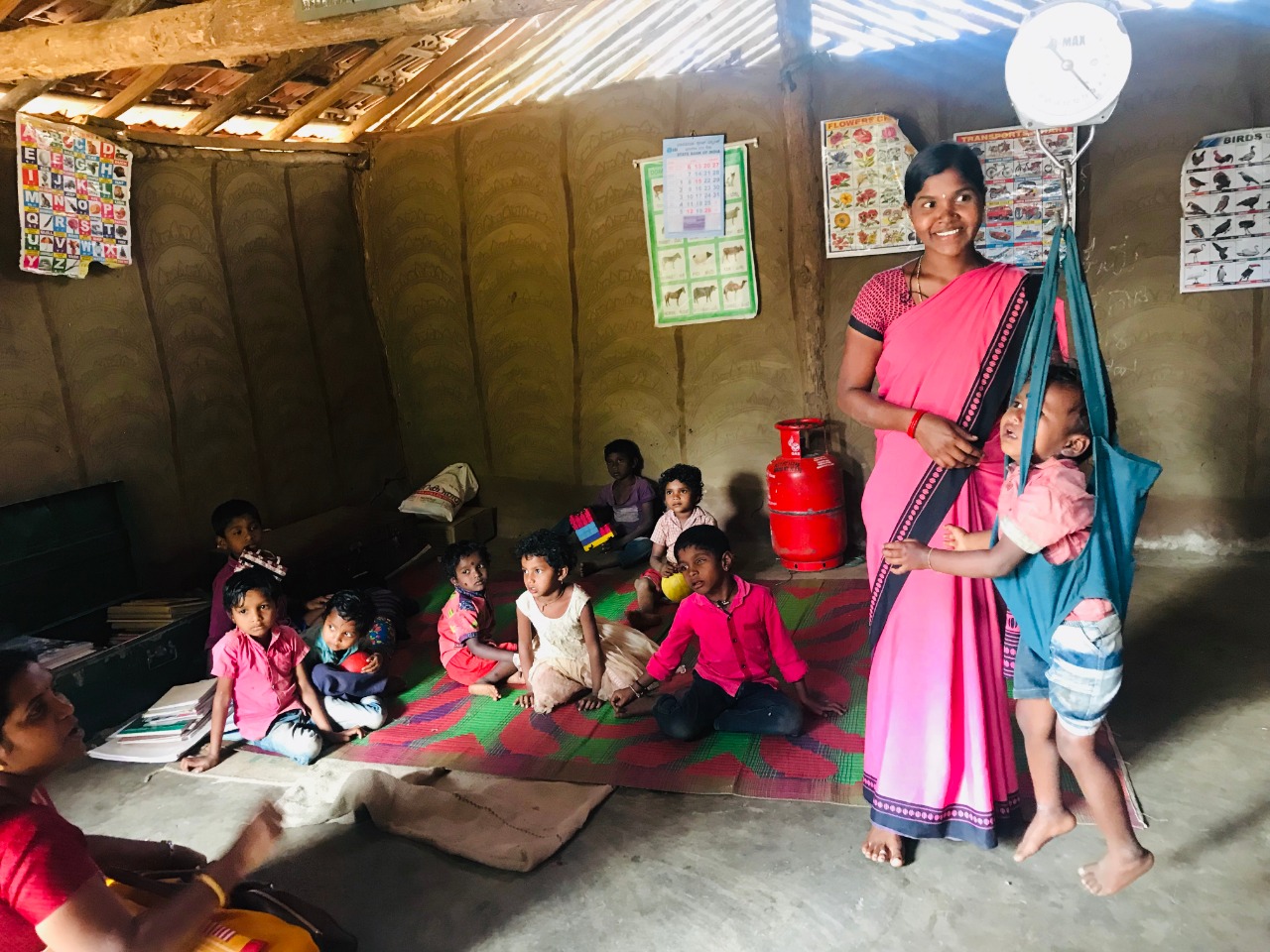
Educational institutes in the country, including anganwadis, are closed (in most of the states) till at least March 31 this year. In states like Uttar Pradesh, the shutdown direction is till April 2. Except Kerala, where the state government is delivering dry ration to mid-day meal and anganwadi children, and some tribal pockets in Maharashtra where hot meals are still being served to anganwadi kids, other states are yet to put in place a mechanism to deliver food to beneficiary children.
“All the government schools in the state are closed till April 2,” an official of the Uttar Pradesh government told Gaon Connection. “Under the mid-day meal scheme, there is provision only for hot cooked meals for children. As of now, there is no direction to supply dry ration to the mid-day meal beneficiaries in the state,” she added.
With the Supreme Court taking suo moto notice, the states will now have to take action and supply at least the dry ration. But dry ration is a poor replacement for hot cooked wholesome meals, said Yogesh Jain, founding member of Jan Swasthya Sahyog (People’s Health Support Group), a non-profit working on public health issues in Chhattisgarh. “The challenge will be to deliver food to mid-day meal scheme kids, as in anganwadis under the ICDS, there still is a provision for take-away dry ration. No such scope exists under the mid-day meal scheme,” he added.
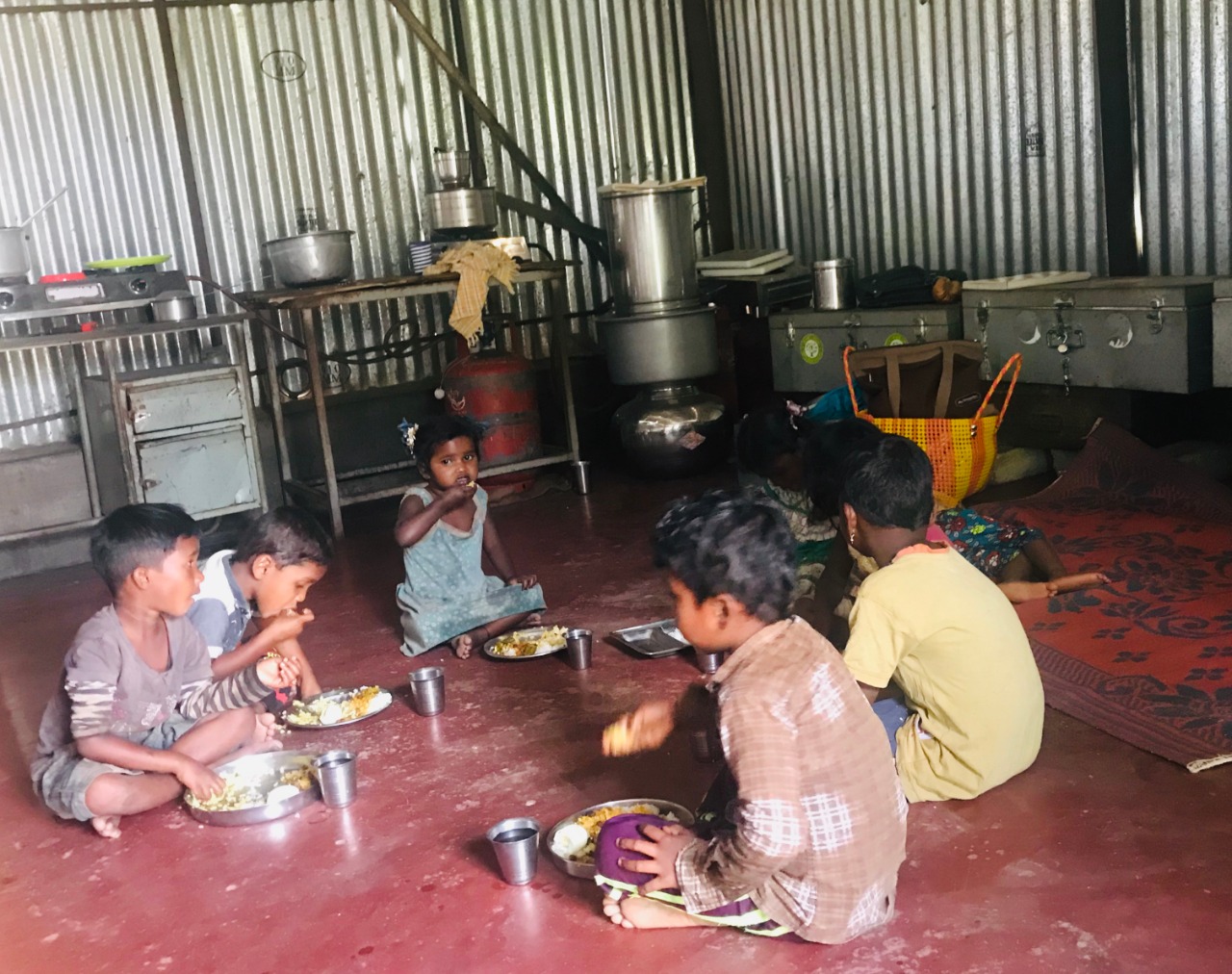
Mid-day meal scheme and supplementary nutrition under ICDS
Under the mid-day meal scheme of the Union ministry of human resource development, daily hot cooked meals are provided to all primary and upper primary students (class 1 to 8) in government schools, government-aided schools and Education Guarantee Scheme schools.
“This is possibly the only wholesome meal children eat in a day; and temporarily making these meals unavailable is going to have serious health implications,” warned Jain. “Because of shutdowns and call for social distancing, daily wagers are already not getting any work. And, no work on an everyday basis means no food at their homes. In such a scenario, shutting down school meals for children is criminal,” he added.
Apart from the mid-day meal, under the Integrated Child Development Services (ICDS) scheme of the Union ministry of women & child development, six services are offered as a package through 1.36 million functional anganwadi centres spread across all the districts in the country (as of June 2018). These services include supplementary nutrition, immunisation, pre-school non-formal education, health check-up, nutrition and health education, and referral services.
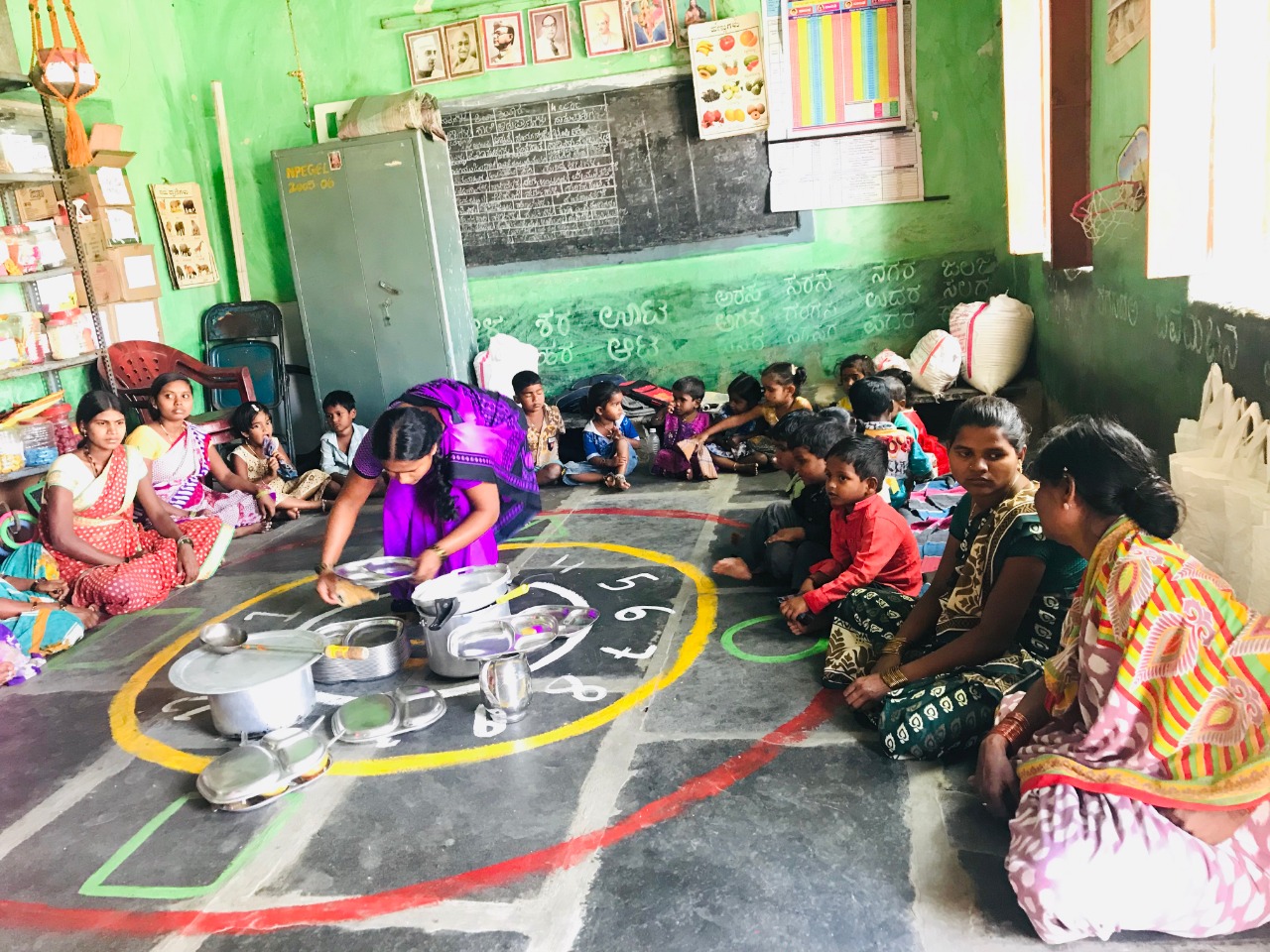
Under the ICDS, children between the age group of 0-3 years are provided take home dry ration, whereas those in 3-6 years group are offered hot cooked meals at the anganwadis. Some states also provide cream milk and eggs to these children. There is provision for meals for pregnant and lactating mothers, too.
But, at present, supplementary nutrition has stopped, as children have been directed not to come to the anganwadis and remain safe at their homes.
As a ‘precautionary measure’, a number of states have ordered shutdown of anganwadis. These include Delhi, Jammu and Kashmir, Tamil Nadu, Himachal Pradesh, Kerala, Haryana, Uttar Pradesh, Bihar, Odisha, Chhattisgarh, Maharashtra, Gujarat, Rajasthan, Madhya Pradesh, Uttarakhand, Assam, Arunachal Pradesh (till April 5), etc.
“On March 10, we received the first direction to close down all anganwadis in the state for a week. Thereafter, on March 16, we received another communication from the Union ministry of women and child development to discontinue Poshan Pakhwada planned this month between March 8-22,” S. Varalakshmi, president of the Karnataka State Anganwadi Workers’ Association told Gaon Connection.
At present, all the anganwadis in Karnataka are shut for children. “Recently, there was a direction to home deliver dry ration to anganwadi kids in the state, but the same is yet to take off,” said Varalakshmi. “Under the Mathrupoorna scheme of Karnataka government, pregnant and lactating mothers are also offered hot cooked meals six times a week at anganwadis. Now, none of these women are coming to the centres to eat those meals,” she added.
Meanwhile, Telangana has reduced anganwadi timings from 9 am-4 pm to 9.30am-11.30am. A decision on shutting down these centres is still under consideration as “the food and care we provide to the children and mother is very necessary and can’t be stopped immediately”, said an official.
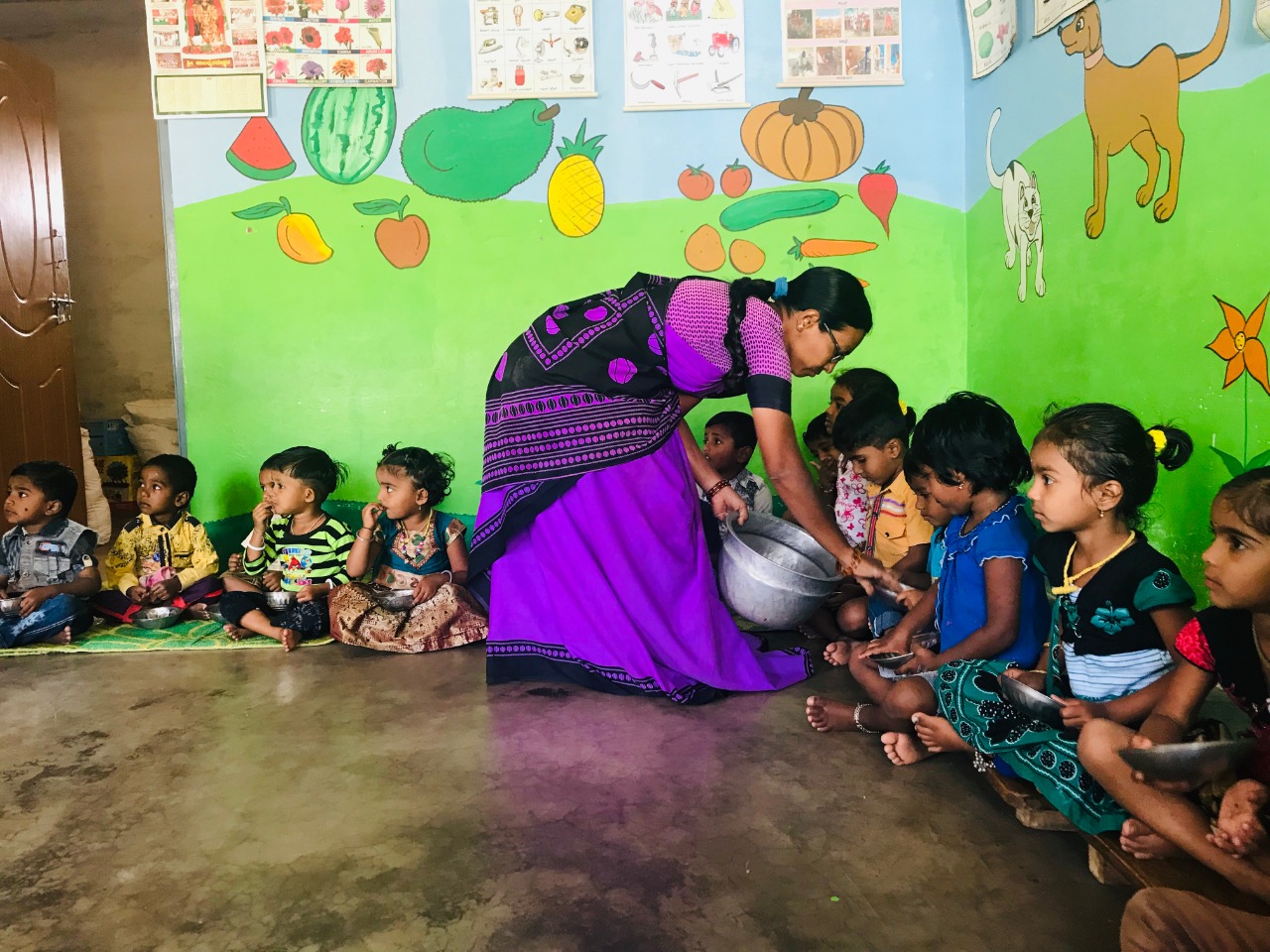
Some states holding the fort
Kerala is possibly the only state home delivering meals (dry ration) to beneficiaries of mid-day meals and anganwadi children. The school teachers and anganwadi workers are packaging dry ration and delivering them to children.
Meanwhile, in some parts of Maharashtra, hot meals are still being offered to the anganwadi kids.
“We did a quick assessment of anganwadis in Mokhada, a tribal block in Palghar district, and found hot meals for anganwadi children were still being cooked,” Shraddha Shringarpure, chief executive officer of Diganta Swaraj Foundation, a non-profit working with tribals in Palghar told Gaon Connection. “In case the anganwadi tai is from the same village, she is delivering hot meals to kids at their homes. Otherwise, children are gathered at some common place and offered their daily cooked meals,” she added.
Palghar in Maharashtra, a tribal dominated district, is often in news for all the wrong reasons —- malnutrition deaths. In 2016, within eight months period, 254 children in the district died due to malnutrition. The worst-affected regions were the Mokhada block, (75 children died), and and Jawhar block, where 47 children died; both predominantly poor tribal areas.
“Whereas hot meals are being served in anganwadis in Palghar, we could not find any such practice in villages of Nashik district. So, a lot also depends on how the local administration is trying to feed the children during these unprecedented times,” said Shringarpure.
Taking note of the present scenario, where nutritional needs of millions of children, and pregnant and lactating mothers is jeopardised, the Supreme Court rightly cautioned “non-supply of nutritional food to the children as well as lactating and nursing mothers may lead to large-scale malnourishment, particularly, in rural and tribal areas”. It went on to note “while dealing with one crisis [COVID-19 pandemic], the situation may not lead to creation of another crisis.”
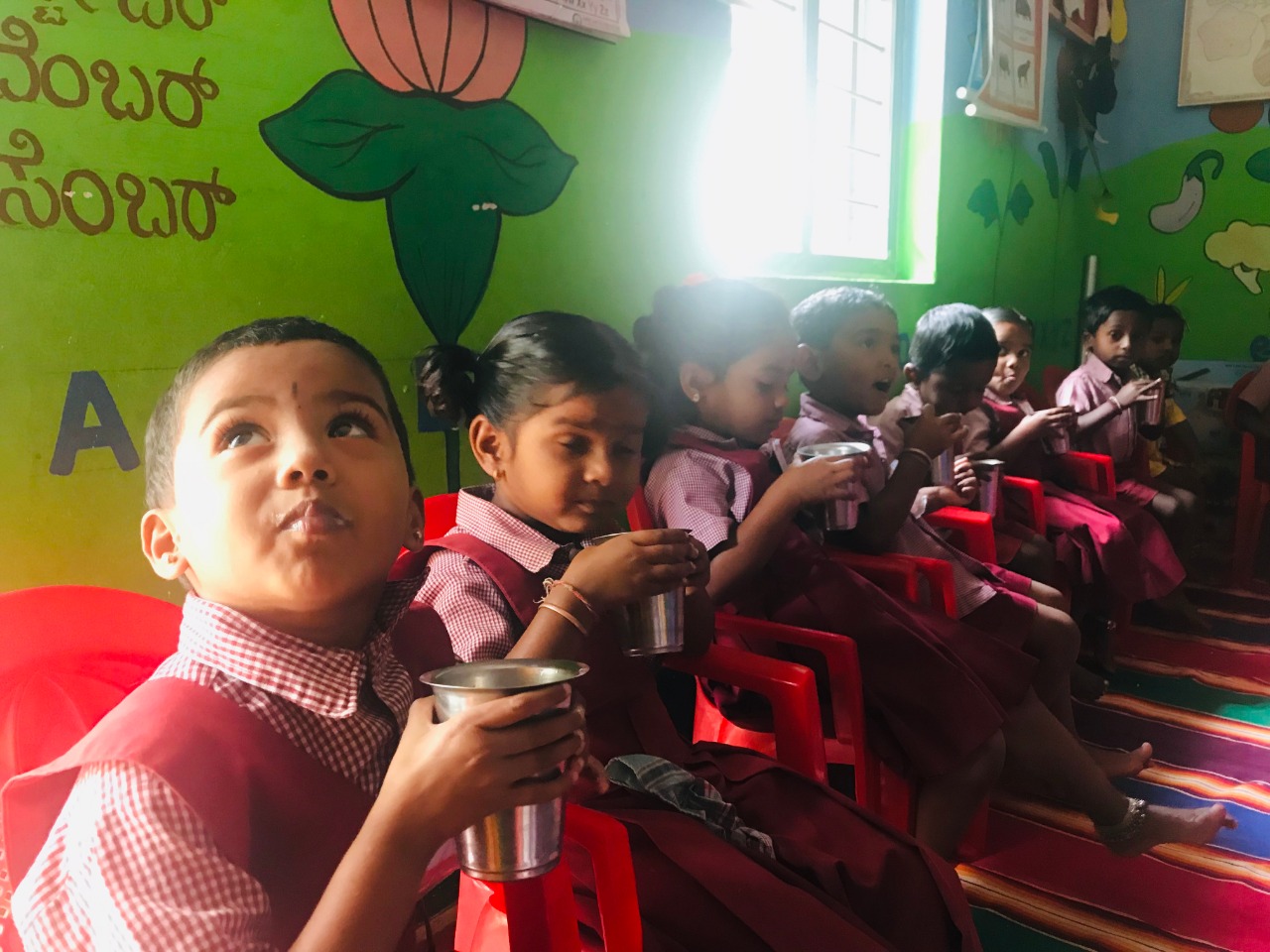
High malnutrition burden
The concerns of the apex court are justified. According to the Union health ministry’s Comprehensive National Nutrition Survey 2016-2018, 35 per cent, 33 per cent and 17 per cent of children under five in the country are stunted (lower height for age), underweight (lower weight for age) and wasted (lower weight for height), respectively (see graphs). About 11 per cent of children aged six to 59 months months were in fact found to be acutely malnourished.

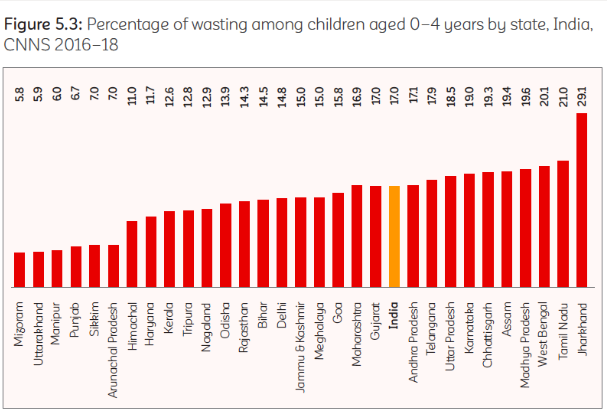
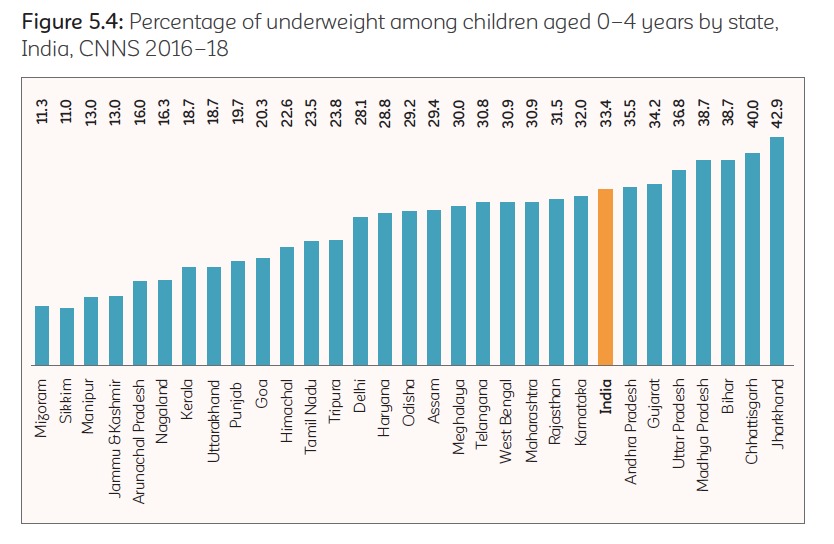
State-wise scenario looks grim. In Bihar, where anganwadis are shut, 42 per cent and 38.7 per cent children in 0-4 years age group are stunted and underweight, respectively. In Chhattisgarh, 40 per cent kids in 0-4 group are underweight and 35.4 per cent are stunted.
In case of children in 5-9 years age group, the 2016-18 survey found 22 per cent children stunted, 23 per cent thin, and 10 per cent under-weight. The survey also reported malnutrition among adolescents (10-19 years). Over 24 per cent adolescents were thin for their age.
“A large number of children in the country are malnourished. Hence, mid-day meal and supplementary nutrition are crucial. In a pandemic situation, these basic health services must not be stopped,” said Jain. “The problem with take-away ration is it gets shared by other family members at home and children often do not consume the required daily calories,” he added.
According to Shringarpure, another challenge is to ensure anganwadis do not run out of their ration stocks. “Amid shutdowns, the government must ensure adequate ration reaches anganwadi centres across the country without any delay, so that anganwadi tai can cook meals for kids, or home deliver dry ration,” she added.
The way COVID-19 pandemic is unfolding, it is not clear for how long social distancing measures and shutdowns will continue. In such a scenario, keeping millions of already under-nourished children hungry would spell another disaster for the country.

